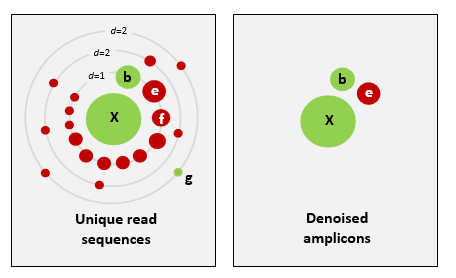See also
UNOISE paper
Should I use UPARSE (97% OTUs) or UNOISE
(denoising)?
The UNOISE algorithm performs error-correction (denoising) on amplicon reads. It is implemented in the unoise3 command.
The original UNOISE algorithm was briefly described in Edgar & Flyvbjerg (2015). An improved algorithm was described and validated in Edgar 2016. The implementation in unoise3 and uchime3_denovo is quite similar to UNOISE2 except for a change in parameters for chimera detection, which I believe greatly reduces the number of false positives over the original parameters described in the UNOISE2 paper that were implemented in the earlier unoise2 and uchime2_denovo commands in usearch v9.
The algorithm is designed for Illumina reads, it does not work as well on 454, Ion Torrent or PacBio reads.
Correct biological sequences are recovered from the reads, resolving distinct sequences down to a single difference (often) or two or more differences (almost always).
Errors are corrected as follows:
- Reads with sequencing
and PCR point error are identified and
removed.
- Chimeras are removed.
Abundances are calculated after denoising by generating an OTU table using the otutab command.

Schematic of the UNOISE2 denoising strategy
(figure from the UNOISE2 paper).
The left panel shows the
neighborhood close to a high-abundance unique read sequence X, grouped by
the number of sequence differences (d). Dots are unique sequences, the size
of a dot indicates its abundance. Green dots are correct biological
sequences; red dots have one or more errors. Neighbors with small numbers of
differences and small abundance compared to X are predicted to be bad reads
of X. The right panel shows the denoised amplicons. Here, X and b were
correctly predicted, e is an error with anomalously high abundance that was
wrongly predicted to be correct, f is an error that was correctly discarded
but has an abundance almost high enough to be a false positive, and g is a
low-abundance correct amplicon that was wrongly discarded. The abundances of
b, e, and f are similar, illustrating the fundamental challenge in
denoising: how to set an abundance threshold that distinguishes correct
sequences from errors.